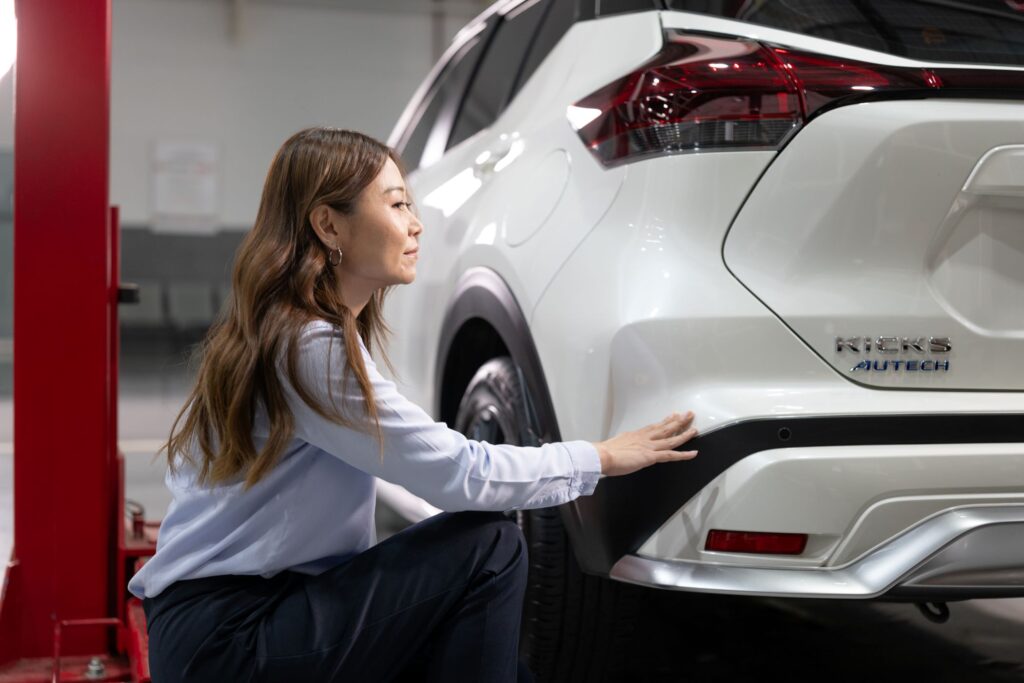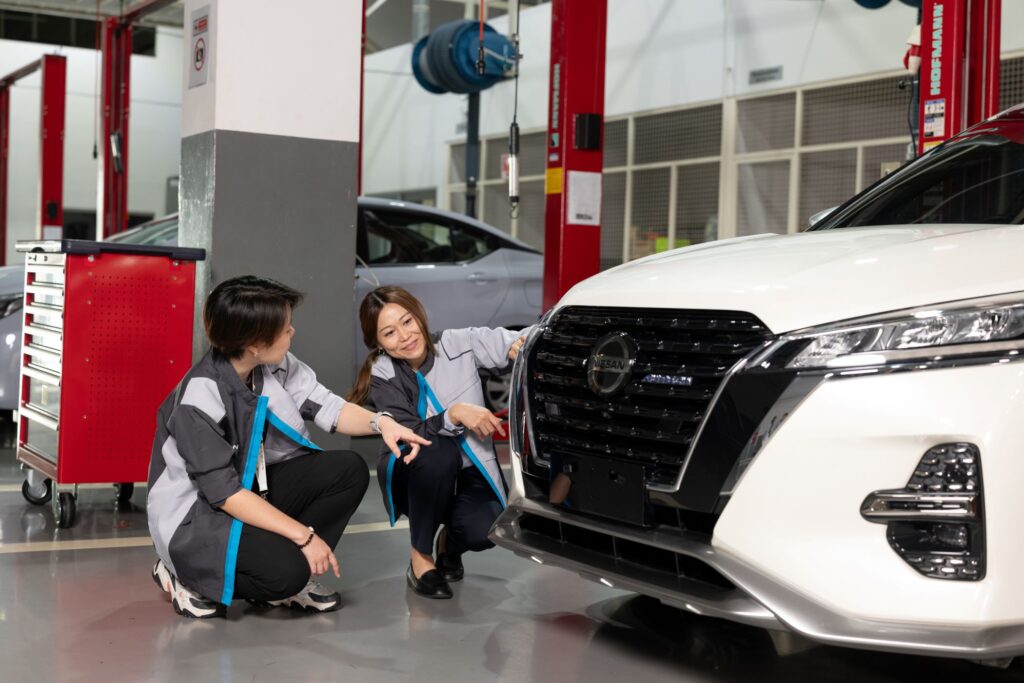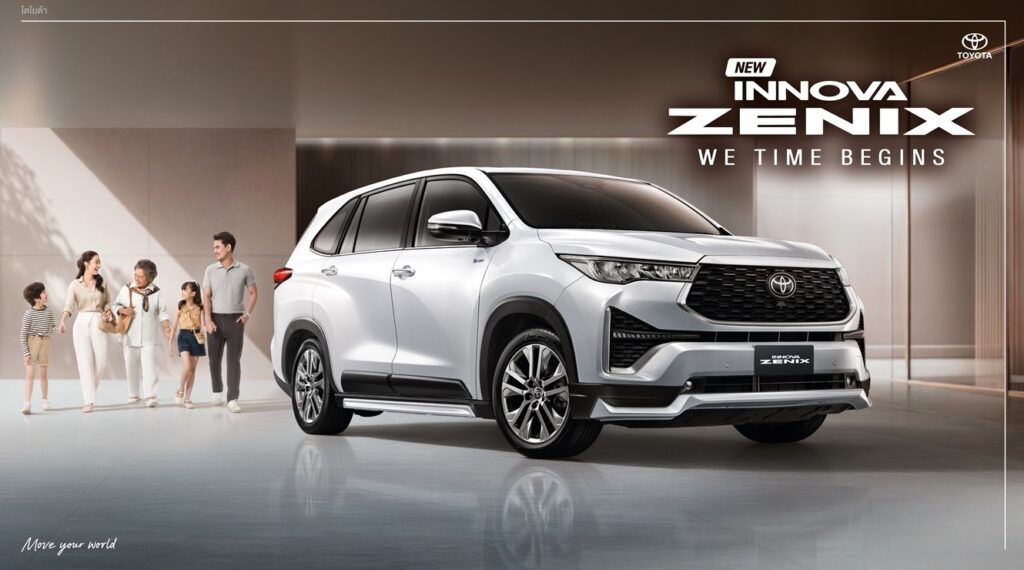
วิศวกรของนิสสัน ได้ท้าทายแนวความคิดของอุตสาหกรรมยานยนต์ที่มีผู้ชายเป็นหลัก โดยใช้ประโยชน์จากความหลากหลายเพื่อสร้างรถยนต์ที่ได้รับการยกย่องในด้านนวัตกรรม ความปลอดภัย และการออกแบบที่เน้นลูกค้าเป็นศูนย์กลาง
ท่ามกลางพื้นที่การทำงานของ นิสสัน มอเตอร์ เอเชีย แปซิฟิก เสียงฮัมเพลงพร้อมบทสนทนา และเสียงเคาะคีย์บอร์ดเป็นจังหวะ พื้นที่อันกว้างขวางผสมผสานกับพื้นที่ทำงานแบบเปิดโล่งที่เข้ากับห้องเล็กๆ แบบดั้งเดิม เป็นที่ทำงานของพนักงานหลายร้อยคนที่จ้องมองหน้าจอของคอมพิวเตอร์ ในขณะที่จ้องไปยังส่วนต่างๆ ของ ไฟล์งาน เอกสาร และการวิเคราะห์โมเดล 3 มิติที่ซับซ้อน ในห้องประชุมเล็กๆ เมื่อมองผ่านกระจก มีทีมที่นั่งรวมตัวกันล้อมรอบตารางบนหน้าจอทีวี การสนทนาแบบเคลื่อนไหวของพวกเขา สะท้อนออกมาจากผนัง
ทีมวิศวกรรมการตกแต่งภายนอก จากแผนกวิจัยและพัฒนา ซึ่งเป็นขุมพลังแห่งนวัตกรรมของนิสสัน ตั้งอยู่ในมุมที่มีแสงแดดส่องถึง หนึ่งในนั้นคือ พรรณทิพา ทองขาว หรือที่รู้จักกันในชื่อ “บิว” แม้ว่ารูปลักษณ์ภายนอกของเธอจะดูไม่ค่อยเข้ากับชุดแจ็กเก็ตยี่ห้อนิสสัน และกางเกงทรงสแล็กสีดำ แต่บิวก็แสดงบทบาทต่างๆ ได้อย่างมีประสิทธิภาพและเหมาะสม ทั้งในฐานะของวิศวกร และผู้บริหารระดับกลาง เธอได้แบ่งปันเรื่องราวการเดินทางของเธอ และความท้าทายของอุตสาหกรรมยานยนต์ ซึ่งส่วนใหญ่ล้วนดำเนินการโดยผู้ชาย เธอและเพื่อนร่วมงานใช้ความหลากหลายในงานของการออกแบบ และการพัฒนารถยนต์ที่ตอบสนองความต้องการ และความคาดหวังของผู้บริโภคในปัจจุบันได้อย่างมีประสิทธิภาพ

สิ่งที่มากกว่าแค่การมองเห็น
บิว เข้าสู่วงการอุตสาหกรรมยานยนต์เมื่อกว่า 10 ปีที่แล้ว ปัจจุบันเป็นผู้นำทีม Exterior Trim Engineering รับผิดชอบการออกแบบ และพัฒนาชิ้นส่วนภายนอกต่างๆ ของรถยนต์ เช่น กระจังหน้า วัสดุตกแต่งฝากระโปรง กันชนหน้าหลัง และอุปกรณ์ตกแต่งภายนอกอื่นๆ ทั้งนี้การพัฒนารถยนต์มีกระบวนการที่ซับซ้อนมากมาย เกี่ยวข้องกับชิ้นส่วนหลายพันชิ้น ซึ่งแต่ละชิ้นต้องได้รับการออกแบบ และทดสอบอย่างพิถีพิถัน
สำหรับวิศวกรที่ดูแลการตกแต่งภายนอกเหมือนบิว งานของพวกเขามีมากกว่าเพียงแค่ความสวยงาม แต่เป็นการผสมผสานระหว่างรูปแบบ และฟังก์ชันการใช้งานที่เกินกว่าที่ตาจะมองเห็น
“การออกแบบชิ้นส่วนภายนอกมีการผสมผสานมากกว่าเพียงแค่ความสวยงาม ปัจจัยต่างๆ เช่น ประสิทธิภาพการขับขี่ และการปฏิบัติตามมาตรฐาน และกฎระเบียบของประเทศที่จะส่งออกไปก็มีความสำคัญเช่นกัน” บิวอธิบาย “ความปลอดภัยก็เป็นอีกหนึ่งข้อพิจารณาที่สำคัญ เมื่อออกแบบชิ้นส่วนต่างๆ เช่น กันชนหน้า เราต้องพิจารณาความต้านทานแรงกระแทก และไดนามิกที่เกิดจากการชนบริเวณกันชน ตลอดจนตรวจสอบให้แน่ใจว่าชิ้นส่วนต่างๆ มีพื้นผิวที่เรียบ และไม่มีขอบแหลมคมที่อาจจะเป็นอันตรายต่อผู้ขับขี่ได้” บิวเสริม
ศาสตร์และศิลป์ของการออกแบบ
รถยนต์มีการพัฒนาอย่างต่อเนื่องเพื่อตอบสนองเทรนด์และความต้องการของผู้บริโภคที่มีการเปลี่ยนแปลง ซึ่งเป็นเหตุผลว่าทำไมบิวจึงติดตามเทรนด์ของยานยนต์ และข้อมูลเชิงลึกของผู้บริโภคอย่างใกล้ชิด ในระหว่างการเดินทาง เธอสังเกตยานพาหนะบนท้องถนนอย่างละเอียด โดยคำนึงถึงสไตล์ และตัวเลือกต่างๆ ของรถยนต์รุ่นต่างๆ
“ในขณะที่เดินทาง บิวได้ดูรถที่คนในประเทศหรือภูมิภาคต่างๆ ขับกัน สีหรือรุ่นไหนที่ได้รับความนิยม มันใช้วัสดุที่ให้ความสปอร์ต หรือเป็นโครเมียม หรือเป็นสีดำ” เธอกล่าว “ตัวอย่างเช่น ในประเทศไทย ความชอบด้านสไตล์ในแต่ละเซ็กเมนต์ค่อนข้างสอดคล้องกัน กลุ่มประชากรอายุน้อยมักชื่นชอบรถยนต์ที่เป็นมิตรต่อสิ่งแวดล้อมอย่าง นิสสัน อัลเมร่า ซึ่งบางครั้งก็ปรับแต่งรูปลักษณ์ภายนอกเพื่อให้ดูสปอร์ตยิ่งขึ้นหรือเป็นสีดำ”
ข้อมูลเชิงลึกดังกล่าวเป็นส่วนสำคัญในงานของบิว ที่ช่วยชี้แนะเธอในการพัฒนา และปรับปรุงการออกแบบรถยนต์ใหม่ที่ตอบสนองความต้องการของผู้บริโภคได้อย่างมีประสิทธิภาพมากขึ้น พวกเขาได้สร้างสรรค์รถยนต์รุ่นต่างๆ ที่เห็นบนท้องถนนในปัจจุบัน เข้าถึงลูกค้านิสสันหลายล้านคน รวมถึงผลงานชิ้นเอกล่าสุดของบิว คือ การสร้างสรรค์ นิสสัน นาวารา แบล็ค อิดิชั่น
โดยปกติแล้ว ขั้นตอนการพัฒนาแนวคิดจะนำโดยสำนักงานใหญ่ในประเทศญี่ปุ่น เมื่อมาถึงประเทศไทย ก็ใกล้จะเข้าสู่ขั้นตอนสุดท้ายของกระบวนการพัฒนาแล้ว ซึ่งตามหลักแล้วเกี่ยวข้องกับการผลิตชิ้นส่วนจริงและการนำไปใช้ อย่างไรก็ตาม ในขณะที่นิสสันขยายธุรกิจในประเทศไทย บิวและทีมงานของเธอจึงรับหน้าที่พัฒนาแนวคิด แบล็ค อิดิชั่น การได้เห็นแนวคิดของเธอกลายเป็นจริงบนท้องถนนถือเป็นช่วงเวลาที่น่าภาคภูมิใจ โดยเน้นย้ำถึงความหลงใหล และการมีส่วนร่วมทางนวัตกรรมที่มีต่อกลุ่มผลิตภัณฑ์ต่างๆ ของนิสสัน

เร่งสร้างนวัตกรรมผ่านการบูรณาการความหลากหลายของทีมงาน
ภายใต้การเป็นผู้นำของบิว ทีมวิศวกรรมตกแต่งภายนอกเป็นตัวแทนของการผสมผสานระหว่าง เพศ สัญชาติ อายุ และประสบการณ์ สิ่งนี้สะท้อนให้เห็นถึงความมุ่งมั่นของนิสสันในการใช้ประโยชน์จากความหลากหลายเพื่อนวัตกรรม แม้ว่าการทำงานในสภาพแวดล้อมที่หลากหลายเช่นนี้จะนำมาซึ่งความท้าทาย บิวเล่าว่าเมื่อเราเอาชนะได้แล้ว เราจะได้รับสิ่งดีๆ อีกมากมาย
“ด้วยสมาชิกในทีมที่มาจากภูมิหลัง เพศ และประสบการณ์ที่หลากหลาย ทุกคนจึงมีมุมมองที่ไม่เหมือนกัน บางครั้งมุมมองที่แตกต่างกันก็เหล่านี้อาจนำไปสู่ความขัดแย้ง หรืออคติโดยไม่รู้ตัว โดยอาจเกิดขึ้นจากภูมิหลัง หรือความเชื่อ” บิวกล่าว “การรับฟังมุมมองของพวกเขาอย่างกระตือรือร้น ถามคำถาม มีส่วนร่วมในการสนทนานอกเวลางานบ้าง และเชื่อมต่อกับพวกเขาในฐานะปัจเจกบุคคลเป็นสิ่งที่สำคัญ”
ที่นิสสัน วัฒนธรรมของความหลากหลาย และการไม่แบ่งแยกสะท้อนให้เห็นจากจำนวนผู้ที่ดำรงตำแหน่งระดับผู้นำทั่วอาเซียน โดยมีทั้งผู้จัดการ และผู้บริหารระดับสูงหลายร้อยคนที่เป็นสุภาพสตรี สิ่งนี้แสดงให้เห็นถึงความพยายามของบริษัทในการส่งเสริม และสร้างสถานที่ทำงานที่ไม่แบ่งแยก ทุกคนมีศักยภาพที่จะประสบความสำเร็จ และความหลากหลายไม่ได้เป็นเพียงแค่คำศัพท์ทั่วไป นิสสันยังมุ่งมั่นที่จะยกระดับด้านความหลากหลาย ความเท่าเทียม และการไม่แบ่งแยก โดยมุ่งมั่นที่จะสร้างสภาพแวดล้อมที่ครอบคลุมมากยิ่งขึ้น ซึ่งพนักงานทุกคนสามารถเติบโตและเป็นตัวเองในเวอร์ชันที่ดีที่สุดของเค้าเหล่านั้นได้
เราทุกคนทำได้
ในโลกของวิศวกรรมยานยนต์ มีความคล้ายกับสิ่งที่บิวชี้ให้เห็น เส้นทางสู่ความหลากหลายทางเพศยังคงดำเนินไปอย่างต่อเนื่อง ในสาขาที่ผู้ชายยังคงมีอิทธิพลในแบบดั้งเดิม เช่น ด้านเทคโนโลยี และด้านยานยนต์ การบรรลุความเท่าเทียมทางเพศถือเป็นเส้นทางที่ท้าทาย ความแตกต่างนี้ไม่ได้จำกัดอยู่เพียงอุตสาหกรรมเหล่านี้เพียงอย่างเดียว ในหลายประเทศในกลุ่มอาเซียน ผู้หญิงยังคงมีบทบาทด้านการบริหารจัดการไม่มากนัก โดยมีผู้ชายซึ่งดำรงตำแหน่งดังกล่าวในสัดส่วนที่สูงกว่า
“บิวได้เห็นการเปลี่ยนแปลงที่โดดเด่นในสาขาวิศวกรรมตั้งแต่เริ่มต้นอาชีพนี้เมื่อกว่า 10 ปีที่แล้ว ก่อนหน้านี้ไม่ใช่เรื่องแปลกที่บุคคลจะถูกส่งเสริมเพื่อรับการเลื่อนตำแหน่ง หรือโอกาสในการพัฒนาเนื่องจากอคติทางเพศ ตอนนี้เป็นเรื่องน่ายินดีที่ได้เห็นผู้หญิงมีบทบาทเป็นผู้นำเพิ่มมากขึ้นในภาคส่วนที่ครั้งหนึ่งเคยครองสัดส่วนโดยผู้ชาย” เธอกล่าว “อย่างไรก็ตาม แม้จะมีความก้าวหน้าเช่นนี้ แต่ทัศนคติแบบเหมารวม และอคติยังมีอยู่ ด้วยเหตุนี้จึงจำเป็นที่จะต้องส่งเสริมความหลากหลาย และการไม่แบ่งแยกในสถานที่ทำงานของเราต่อไป และมุ่งมั่นที่จะเป็นตัวแทนของผู้หญิงในตำแหน่งผู้นำให้มากขึ้น”
เมื่อถูกถามถึงวิธีส่งเสริมให้มีตัวแทนผู้หญิงในสาขาต่างๆ เช่น เทคโนโลยีและวิศวกรรมมากขึ้น เธอตอบอย่างชัดเจนว่า “เราต้องแน่ใจว่าไม่มีอุปสรรคในการเข้าสู่อุตสาหกรรมต่างๆ ตัวอย่างเช่น การใช้ภาษาที่เป็นกลางทางเพศในคำบรรยายลักษณะงาน สำหรับบทบาทหน้าที่ที่มักจะจ้างแต่ผู้ชาย สิ่งนี้สามารถขยายขอบเขตการค้นหาบุคคลที่มีคุณสมบัติเหมาะสมได้ไม่ว่าจะเพศใด”
ในขณะที่เราเฉลิมฉลองวันสตรีสากลในงานวิศวกรรม เราได้ให้ความสำคัญกับบุคคลที่เป็นเหมือนบิว ซึ่งการเดินทางของเธอเป็นแรงบันดาลใจ และปูทางให้วิศวกรหญิงรุ่นต่อไปให้กล้าฝัน และกล้าที่จะเป็นผู้นำ
“หลังจากทำงานด้านวิศวกรรมมา บิวรู้สึกว่าไม่มีอะไรที่ผู้หญิงทำไม่ได้ วิศวกรรมไม่มีขอบเขตทางเพศ ใครๆก็สามารถประกอบอาชีพนี้ได้ไม่ว่าจะเพศใดก็ตาม” บิวกล่าว
The Drive for Change: How Diversity Fuels Automotive Innovation
Nissan’s engineer Panthipa Thongkaow challenges the notion of a male-dominated automotive industry, leveraging diversity to build cars that are celebrated for their innovative, safety, and customer-centric design
BANGKOK, Thailand (June 27, 2024) – Amidst the bustling floor of Nissan Motor Asia Pacific in Thailand, the air hums with quiet conversations and the rhythmic tapping of keyboards. The vast space blends open-plan workstations with traditional cubicles, housing hundreds of employees whose eyes are fixed on laptop screens as they navigate spreadsheets, compose documents, and dissect intricate 3D models. In a smaller meeting room, glimpsed through a mirror, a team huddles around a chart on a TV screen, their animated discussion echoing off the walls.
Nestled in a sunlit corner sits the Exterior Trim Engineering team from the Research and Development Division—a powerhouse of innovation at Nissan. Among them is Panthipa Thongkaow, affectionately known as “Bew.” Despite her unassuming appearance in a Nissan-branded jacket and black navy slacks, Bew is highly effective, seamlessly juggling her roles. As both an engineer and a middle-level manager, she shares her journey of defying the perception of the automotive industry as traditionally male-dominated. Harnessing the power of diversity, she and her colleagues design and develop cars that effectively cater to the diverse needs and expectations of today’s consumers

More Than Meets the Eyes
Bew, who entered the automotive industry over a decade ago, currently leads the Exterior Trim Engineering team, responsible for exterior parts design and development, such as the front grille, hood ornament, front and rear bumpers, and other exterior accessories. Car development is an intricate process, involving thousands of parts, each meticulously designed and tested.
For exterior trim engineers like Bew, their work extends far beyond mere aesthetics—it’s a blend of form and function that goes beyond what meets the eye.
“Exterior parts design incorporates more than just aesthetics. Factors such as driving performance and compliance with standards and regulations in export countries are also crucial,” Bew explains. “Safety is also another key consideration. When designing parts like a front bumper, we need to consider the bumper’s impact resistance and collision dynamics as well as ensuring that parts are smooth and free of sharp edges that could potentially harm drivers,” she continues.
The Art and Science of Car Design
Cars continually evolve to meet changing trends and consumer preferences, which is why Bew closely monitors automotive trends and consumer insights. During her travels, she keenly observes the vehicles on the road, noting styling preferences and choices in vehicle models.
“When I travel, I look at the cars people in different countries or regions drive, which colors or models are popular. Is it sporty, chrome, or black?,” she says. “For example, in Thailand, styling preferences across segments are fairly consistent. Younger demographics often favor eco-friendly cars like the Almera, sometimes customizing their exteriors for a sportier or black appearance.”
Such insights are instrumental in Bew’s work, guiding her in developing and refining new car designs that more effectively meet consumer preferences. They have shaped the car models seen on roads today, reaching millions of Nissan customers, including Bew’s masterpiece: the creation of the Nissan Navara Black Edition.
Traditionally, the concept development phases were led by headquarters in Japan. By the time it reached Thailand, it was already nearing the final stages of the development process, which primarily involved the physical production of a part and its implementation. However, as Nissan’s footprint in Thailand expanded, Bew and her team took charge of developing the Black Edition concept. Witnessing her ideas come to life on the road was a proud moment, highlighting their passion and innovative contributions to Nissan’s product lineup.
Accelerating Innovation Through Inclusion
Under Bew’s leadership, the Exterior Trim Engineering team represents a mix of genders, nationalities, age, and experiences. This reflects Nissan’s commitment to leveraging diversity for innovation. While working in such a diverse environment presents some challenges, Bew shares that once they are overcome, there is so much more to gain.
“With team members from diverse backgrounds, genders, and experiences, everyone brings unique perspectives. Sometimes, these differing viewpoints can lead to conflict, or unconscious biases may arise based on someone’s background or belief,” Bew says. “It’s crucial to actively listen to their perspectives, ask questions, engage in conversations outside of work, and connect with them as individuals.”
At Nissan, the culture of diversity and inclusion is reflected in the number of women holding leadership positions across ASEAN, with hundreds of managers and executives at Nissan ASEAN being female. This demonstrates the company’s efforts to promote and build an inclusive workplace where everyone is empowered to thrive and where diversity is not just a buzzword. Nissan is also committed to further enhancing its diversity, equity, and inclusion efforts, striving for an even more inclusive environment where all employees can grow and be the best version of themselves.

We Can Do Anything
In the world of automotive engineering, similar to what Bew pointed out, the road to gender diversity has always been a work in progress. In traditionally male-dominated fields such as technology and automotive, achieving gender parity has been a challenging journey. This disparity is not limited to these industries alone. Across many ASEAN countries, women continue to be underrepresented in management roles, with a higher proportion of such positions held by men.
“I have seen notable changes in the engineering field since the start of my career over a decade ago. Previously, it was not uncommon for individuals to be passed over for promotions or development opportunities due to gender biases. Now, it’s encouraging to see an increase in women occupying leadership roles within sectors that were once predominantly male,” she says. “However, despite this headway, stereotypes and biases still persist. This is why it’s imperative to continue promoting diversity and inclusion in our workplaces and to strive for greater representation of women in leadership positions.”
When asked how to encourage more female representation in fields like technology and engineering, Bew’s response is clear: “We need to ensure there are no entry barriers across industries. For instance, using gender-neutral language in job descriptions for roles often filled by men can broaden the search for qualified individuals.”
As we celebrate International Women in Engineering Day, we turn the spotlight on individuals like Bew, whose journey inspires and paves the way for future generations of women engineers who dare to dream and dare to lead.
“Having worked in the engineering field, I feel there’s nothing women can’t do. Engineering knows no gender boundaries. Anyone, regardless of gender, can pursue a career in this field,” Bew reflects.







